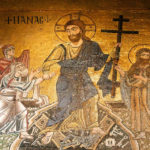We run our website the way we wished the whole internet worked: we provide high quality original content with no ads. We are funded solely by your direct support. Please consider supporting this project.
Jesus: True Myth and True History
Though the Jesus story gives us every reason to believe it is substantially rooted in history, it has a curious, and fascinating, relationship with myth and legend.
The story of God coming to earth, being born of a virgin, manifesting a heroic, counter-cultural love toward outcasts, dying for the people who crucified him and then rising from the dead has a familiar “echo” to it. If we haven’t completely deafened our ears to it, hearing this story has an affect on us that is a bit like recalling a long forgotten dream. On some level, there’s a part of us that seems to intuitively “remember” something when we come in contact with the loving savior portrayed in the Gospels. Though it may be suppressed under layers of cynicism and apathy produced by the harshness or sheer monotony of life, and though we may not be able to express it in words, something within us senses that this story puts us in touch with a dream about the way things are supposed to be. It reconnects us with something we’ve lost along the way, something we’ve perhaps given up on, something we’ve forgotten.
Throughout history, and in every culture, people have, in a wide variety of ways, recalled this dream, even without having had any contact with the Jesus story. They’ve expressed this dream through myths and legends. We in modern western culture sometimes respond to unbelievable stories by saying, “Oh, that is just a myth.” “Myth” and “legend” are for most people equivalent to “untrue.” (Hence the visceral fear some modern Christians have about conceding anything in the Bible may be myth). But, as the great mythologist Joseph Campbell has noted, there is a much more profound sense in which myths and legends can be very true. At their best, myths and legends express our innermost sense of reality, our deepest longings, the obstacles we face in pursuing these longings, and our hope that somehow, someday, these longings will be satisfied. (1) In other words, myths and legends express a dream.
Campbell’s observation goes a long way in explaining the curious relationship the Jesus story has with myth and legend. While the Jesus story is unquestionably grounded in history (See P. Eddy & G. Boyd, The Jesus Legend) it nevertheless bears a certain resemblance to certain myths and legends. The resemblance is due to the fact that this story incarnates in actual history the sense of reality, the longing, the obstacles and the hopes that all great myths and legends express. In Jesus, God shows his love for the world by becoming a human, serving sinners, dying on a cross, rising from the dead, defeating the devil, rescuing humanity and giving them eternal life in fellowship with himself. This is the heart of the Jesus story, and it expresses and addresses a dream that is buried in the depths of the human heart.
While some have tried to use mythic and legendary parallels to argue against the historicity of the Jesus story, these vague mythic and legendary parallels are actually what we should expect if indeed the Jesus story is “true”—in the fullest sense of the term. After all, one aspect of the Jesus story, extending back into the Old Testament, is the teaching that humans are made in the image of God (Gen. 1:26-28). We’re thus “wired” for God, if you will. Not only this, but the New Testament itself declares that Jesus is the light “of all people” (John 1:4, 9) who is always working in the hearts of all people to lead them back to himself (Acts 17:26-28, cf. Rom 1:19-20). (2) We should thus expect to find “echoes” of the Jesus story expressed in the myths and legends of all people.
C. S. Lewis expresses this insight when he writes:
Theology, while saying that a special illumination has been vouchsafed to Christians and (earlier) to Jews, also says that there is some divine illumination vouchsafed to all men… We should, therefore, expect to find in the imagination of the great Pagan teachers and myth makers some glimpse of that theme which we believe to be the very plot of the whole cosmic story—the theme of incarnation, death, and rebirth. (3)
The difference between these myths and legends, on the one hand, and the Jesus story, on the other, is not a “difference between falsehood and truth.” They are both true, but in different senses. As Lewis continues, the difference between them is,
…the difference between a real event on the one hand and dim dreams or premonitions of that same event on the other. It is like watching something come gradually into focus; first it hangs in the clouds of myth and ritual, vast and vague, then it condenses, grows hard and in a sense small, as a historical event in first century Palestine. (4)
This is why Lewis contended that Jesus was “Myth became Fact.” In Jesus, “the essential meaning of all things came down from the ‘heaven’ of myth to the ‘earth’ of history.”(5) The dream expressed in myth and legend, including the premonition of a dying and rising God, is perfectly expressed and becomes historically true in the story of Jesus of Nazareth.
The famous author of the “Lord of the Rings” trilogy, J.R. Tolkien, makes the same point when he says,
The Gospels contain a fairy-story…which embraces all the essence of fairy-stories. They contain many marvels—peculiarly artistic, beautiful, and moving: ‘mythical’ in their perfect, self-contained significance; and among the marvels is the greatest and most complete conceivable eucatastrophe [viz. a climatic eruption of joy].
Yet, the story of Jesus in the New Testament isn’t only a fairy-story, according to Tolkien, but a fairy-story incarnated in real time and space. In the person of Jesus, an all-embracing fairy-story
…has entered History and the primary world; the desire and aspiration of sub-creation has been raised to the fulfillment of Creation. The Birth of Christ is the eucatastrophe of Man’s history. The Resurrection is the eucatastrophe of the story of the Incarnation. The story begins and ends in joy. It has pre-eminently the ‘inner consistency of reality.’ There is no tale ever told that men would rather find was true, and none which so many skeptical men have accepted as true on its own merits. . .
And from this Tolkien concludes:
[The Christian] story is supreme; and it is true. Art has been verified. God is the Lord, of angels, and of men—and of elves. Legend and History have met and fused. (6)
What Lewis and Tolkien are saying is that the Jesus story fulfills the intuitions and longings expressed in many myths and legends. The God revealed in the life, death and resurrection of Jesus Christ is the reality to which certain aspects of various myths and legends point. Jesus is the reality all authors of myths and legends, together with the rest of us, dream of.
If we are honest with ourselves, and if we grasp the depth of the “good news” this story embodies, something quite like the Jesus story is what we hope to be true. Yet, most amazingly, this story gives us reason to believe it is historically true.
We have reason, therefore, to conclude that this story is, at the same time, both true myth and true history.
Adapted from G. Boyd & P. Eddy, Lord or Legend? (Baker, 2007).
Endnotes
(1) J. Campbell, The Inner Reaches of Outer Space: Metaphor as Myth and Religion (New York: van der Marck, 1986) 55.
(2) for example D. Richardson, Eternity in Their Hearts, rev. ed. (Ventura, CA: Regal, 1984 [1981]); idem, Peace Child, 3rd ed. (Glendale, CA: Regal, 1976 [1974]).
(3) C. S. Lewis, “Is Theology Poetry?,” in his The Weight of Glory, and Other Addresses, rev. ed. (New York: Macmillan, 1980 [1949]) 128.
(4) Ibid., 128-29.
(5) Ibid., 129-30. See also C. S. Lewis, “Myth Became Fact,” in God in the Dock: Essays on Theology and Ethics, ed. W. Hooper (Grand Rapids: Eerdmans, 1970) 63-67.
(6) J. R. R. Tolkien, “On Fairy-Stories,” in his Leaf and Tree (Boston: Houghton Mifflin, 1965) 71-72.
Category: Essays
Tags: Apologetics, Essay, Jesus
Topics: Jesus: Lord or Legend
Related Reading

Open Theism Timeline
Open Theism Timeline by Tom Lukashow An argument that is frequently raised against the open view is that it is a recent innovation. Paul Eddy had discovered Calcidius, a fifth century advocate, and I and others knew of L.D. McCabe and Billy Hibbard, two 19th century advocates. But that was about it – until I…

The Old Testament Is NOT on the Same Plane as the New Testament
Paul taught that unbelievers are blinded by “the god of this age” when they read the OT such that “their minds are made dull” and a “veil covers their hearts…when the old covenant is read” (2 Cor. 4:4; 3:14-15). This is why they are unable to see “the light of the knowledge of God’s glory…

How should evangelicals “do” theology?
A central debate among evangelical theologians concerns the question of theological method. In other words, how should we “do” theology? All evangelical Christians believe the Bible is God’s inspired revelation. Thus, evangelicals agree that Scripture must form the foundation for theological thought. But Scripture is not the only factor to consider when doing theology. Many…

Did Jesus Instruct Us to Arm Ourselves?
Over the past few posts, I’ve been dealing with the passages that are frequently used to argue how Jesus condoned violence. One of these takes place just after the last supper and just before Jesus and his disciples were going to travel to the Mount of Olives to pray. To prepare his disciples, Jesus tells them;…

Participating in the Divine Nature (Love)
When God created the world, it obviously wasn’t to finally have someone to love, for God already had this, within himself. Rather God created the world to express the love he is and invite others in on this love. This purpose is most beautifully expressed in Jesus’ prayer in John 17. Jesus prays to his…

How the Anabaptists Emphasized the Cross
Because the Anabaptists have generally emphasized faith that is evidenced by works and thus on Jesus’ life as an example to be followed, it may prima facia appear that the saving work of the cross was less central to the early Anabaptists than it was to the Reformers and to Evangelicals. In reality, I would argue,…
